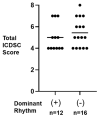The Presence/Absence of an Awake-State Dominant EEG Rhythm in Delirious Patients Is Related to Different Symptoms of Delirium Evaluated by the Intensive Care Delirium Screening Checklist (ICDSC)
- PMID: 39771830
- PMCID: PMC11679350
- DOI: 10.3390/s24248097
The Presence/Absence of an Awake-State Dominant EEG Rhythm in Delirious Patients Is Related to Different Symptoms of Delirium Evaluated by the Intensive Care Delirium Screening Checklist (ICDSC)
Abstract
(1) Background: Delirium is a serious condition in patients undergoing treatment for somatic diseases, leading to poor prognosis. However, the pathophysiology of delirium is not fully understood and should be clarified for its adequate treatment. This study analyzed the relationship between confusion symptoms in delirium and resting-state electroencephalogram (EEG) power spectrum (PS) profiles to investigate the heterogeneity. (2) Methods: The participants were 28 inpatients in a general hospital showing confusion symptoms with an Intensive Care Delirium Screening Checklist (ICDSC) score of 4 or above. EEG was measured at Pz in the daytime awake state for 100 s with the eyes open and 100 s with the eyes closed on the day of the ICDSC evaluation. PS analysis was conducted consecutively for each 10 s datum. (3) Results: Two resting EEG PS patterns were observed regarding the dominant rhythm: the presence or absence of a dominant rhythm, whereby the PS showed alpha or theta peaks in the former and no dominant rhythm in the latter. The patients showing a dominant EEG rhythm were frequently accompanied by hallucination or delusion (p = 0.039); conversely, those lacking a dominant rhythm tended to exhibit fluctuations in the delirium symptoms (p = 0.020). The other ICDSC scores did not differ between the participants with these two EEG patterns. (4) Discussion: The present study indicates that the presence and absence of a dominant EEG rhythm in delirious patients are related to different symptoms of delirium. Using EEG monitoring in the care of delirium will help characterize its heterogeneous pathophysiology, which requires multiple management strategies.
Keywords: Intensive Care Delirium Screening Checklist; delirium; dominant rhythm; electroencephalography; eyes opening and closing; hallucination or delusion; symptom fluctuation.
Conflict of interest statement
The authors declare no conflicts of interest. Yujiro Shinba belonged to the company Autonomic Nervous System Consulting, but the research was conducted in the absence of any commercial or financial relationships that could be construed as a potential conflict of interest.
Figures



Similar articles
-
Predicting hospital mortality and length of stay: A prospective cohort study comparing the Intensive Care Delirium Screening Checklist versus Confusion Assessment Method for the Intensive Care Unit.Aust Crit Care. 2023 May;36(3):378-384. doi: 10.1016/j.aucc.2022.01.010. Epub 2022 Mar 7. Aust Crit Care. 2023. PMID: 35272910
-
Screening for delirium with the Intensive Care Delirium Screening Checklist (ICDSC): Symptom profile and utility of individual items in the identification of delirium dependent on the level of sedation.Palliat Support Care. 2019 Feb;17(1):74-81. doi: 10.1017/S1478951518000202. Epub 2018 May 24. Palliat Support Care. 2019. PMID: 29792239
-
Individual delirium symptoms: do they matter?Crit Care Med. 2007 Nov;35(11):2533-7. doi: 10.1097/01.ccm.0000284506.43390.f3. Crit Care Med. 2007. PMID: 18084841
-
The predictive value of confusion assessment method-intensive care unit and intensive care delirium screening checklist for delirium in critically ill patients in the intensive care unit: A systematic review and meta-analysis.Nurs Crit Care. 2024 Nov;29(6):1224-1235. doi: 10.1111/nicc.13064. Epub 2024 Mar 27. Nurs Crit Care. 2024. PMID: 38538305
-
EEG in delirium.Semin Clin Neuropsychiatry. 2000 Apr;5(2):86-92. doi: 10.153/SCNP00500086. Semin Clin Neuropsychiatry. 2000. PMID: 10837097 Review.
Cited by
-
Predicting delirium in critically Ill COVID-19 patients using EEG-derived data: a machine learning approach.Geroscience. 2025 Jul 23. doi: 10.1007/s11357-025-01809-0. Online ahead of print. Geroscience. 2025. PMID: 40702284
References
-
- American Psychiatric Association . Diagnostic and Statistical Manual of Mental Disorders: DSM-5. 5th ed. American Psychiatric Association; Washington, DC, USA: 2013.
MeSH terms
LinkOut - more resources
Full Text Sources
Medical

